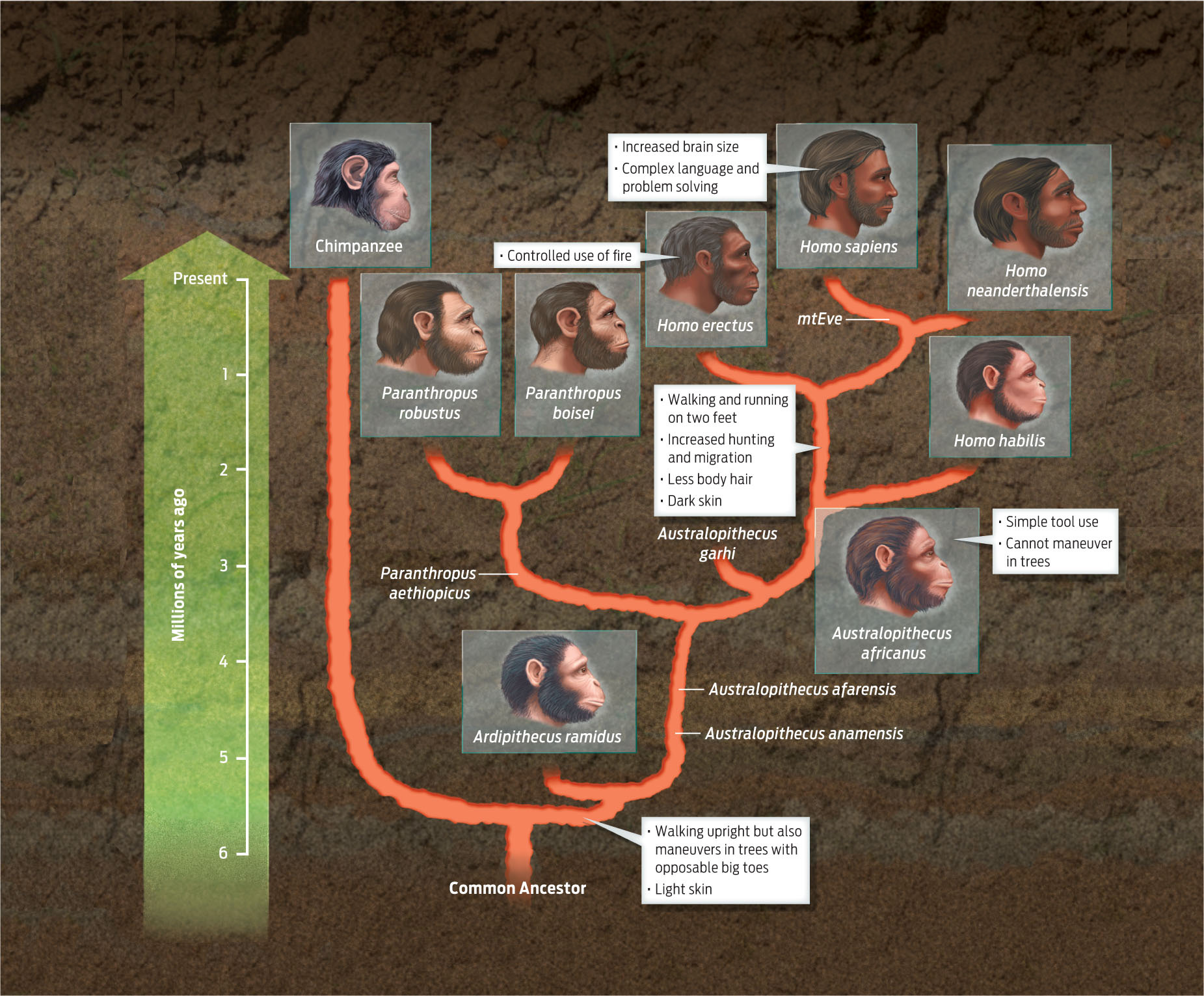Becoming Human
HOMINID Any living or extinct member of the family Hominidae, the great apes—humans, orangutans, gorillas, chimpanzees, and bonobos.
A number of lines of evidence peg Mitochondrial Eve as the most recent matrilineal common ancestor of all humans living today. However, she represents merely one branch on the evolutionary tree that includes our species; this tree has several other branches representing other hominid species. A hominid is any member of the biological family Hominidae, which includes living and extinct great apes (humans, orangutans, gorillas, chimpanzees, and bonobos).
Humans are grouped with the great apes because fossil evidence shows that modern humans and other present-day great apes evolved from a common ancestor that lived 13 million years ago. Of the living members of this group, humans and chimpanzees are the most closely related, although it has been about 7 million years since their last shared ancestor lived. During those 7 million years, both humans and chimps have undergone a tremendous amount of evolutionary change, which is why living humans look and behave so differently from chimps—or any other primate species living today.
441
Scientists haven’t yet discovered fossil remains of the last common ancestor of chimps and humans. However, in October 2009 the first analyses of fossil remains of a 4.4-million-year-old hominid, Ardipithecus ramidus, nicknamed Ardi, were published. Ardi’s remains are among the oldest hominid fossils so far discovered and, as such, give tantalizing clues to early human origins.
Among the defining characteristics of Homo sapiens are the ability to walk upright and a big brain. An upright gait meant the hands were free to make and use tools; a big brain enabled H. sapiens to develop complex language. Which came first, a big brain or walking upright? Ardi provides the answer: Ardi had a small brain, suggesting that it could not use complex language. But Ardi’s bones clearly show that it could walk upright without dragging its knuckles, while still able to maneuver on all fours in trees. The ability to walk upright therefore evolved first and was a major step toward becoming human.
The fossil record after Ardi also reveals some of the major milestones in human evolution. For example, artifacts found at various archeological sites indicate that simple tool use began approximately 2.6 million years ago, most likely when our hominid ancestors began eating meat from large animals. The first tool-users were members of the genus Australopithecus. This genus walked upright and appears to have lived on the ground, rather than in trees, as evidenced by the lack of an opposable big toe, which had helped the early hominids grip branches.
Another milestone was the ability to use and control fire, which appeared about 800,000 years ago. Artifacts such as clay shards found at various fossil sites show that Homo erectus was likely the first species able to control fire. Using fire enabled Homo erectus to cook meat and bone marrow, to stay warm, and probably to fight off predators.
Finally, at some point between 800,000 and 200,000 years ago, hominid brain size began to expand rapidly. Studies of fossilized organisms from ocean sediments show that this was also a time of climate instability. The temperature dramatically shifted from high to low and back several times during this period. Scientists hypothesize that a larger brain would have enabled better communication and problem solving, which would have been very useful to our hominid ancestors as they coped with climate change. This was also around the time that anatomically modern humans like Mitochondrial Eve and our own species, Homo sapiens, appeared (INFOGRAPHIC 20.8) .
Homo sapiens is the only surviving lineage in the evolutionary history of humans. In other words, several hominids have existed or coexisted as related but distinct species in the past. The physical traits of modern-day humans, such as skin color and body hair, evolved in response to selective pressures. A species with less hair could better regulate body temperature in hot and sunny environments, for example, but would require darker skin to protect it from high UV light exposure.
